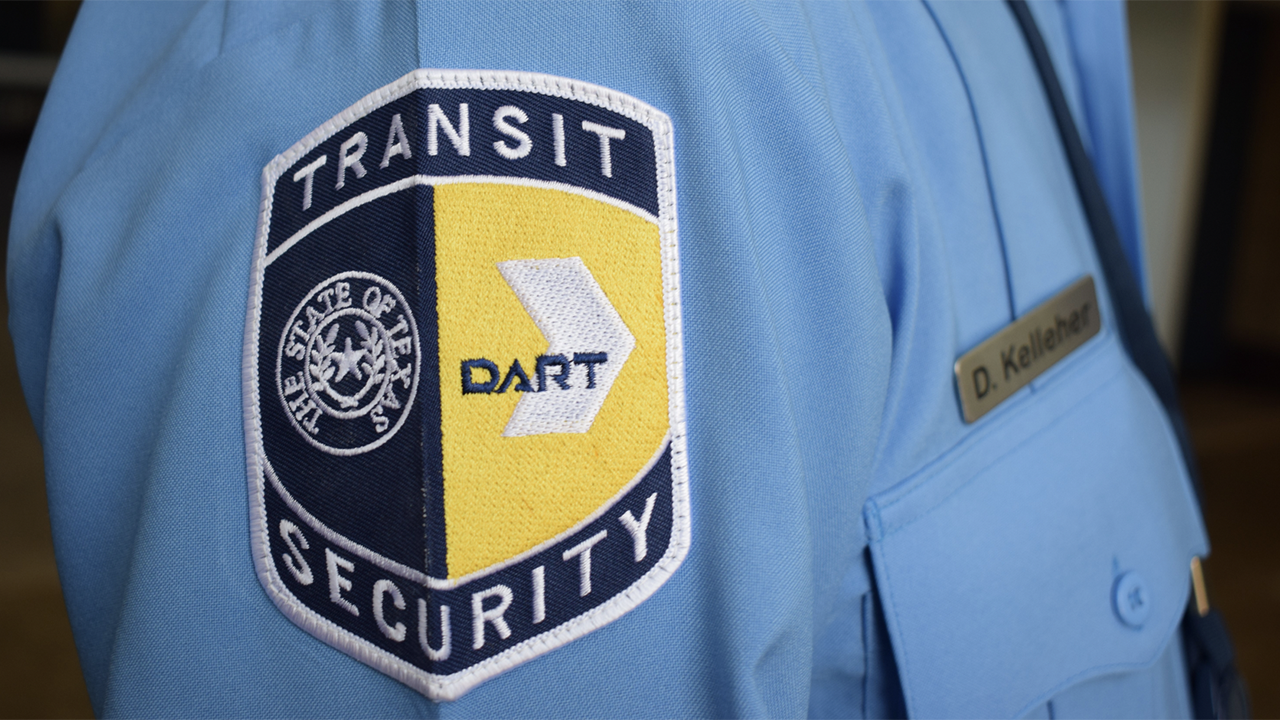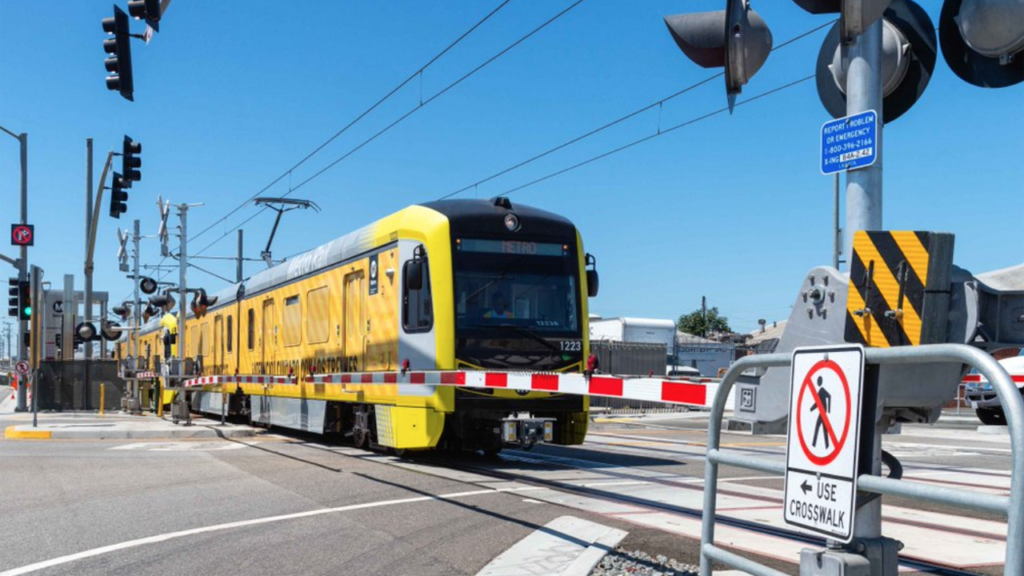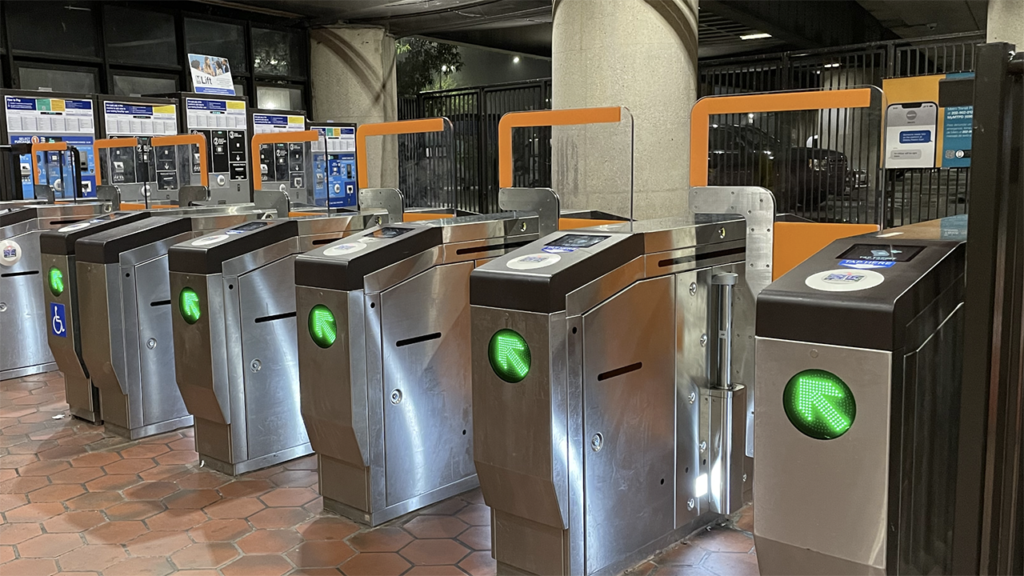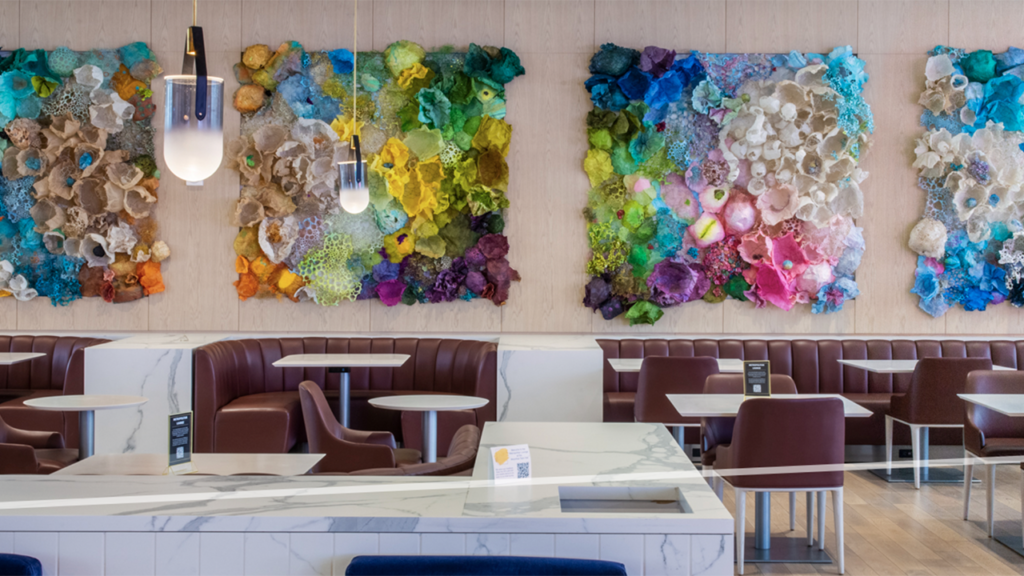
Transit Briefs: DART, LACMTA, OC Transpo, WMATA, Amtrak
Written by Marybeth Luczak, Executive Editor
DART is adding more than 100 contract transit security officers to improve public safety and security for riders onboard its light rail vehicles and Trinity Railway Express commuter railcars and at stations. (DART Photograph)
Contract transit security officers will join Dallas (Tex.) Area Rapid Transit’s (DART) police and fare enforcement officer team. Also, Los Angeles County Metropolitan Transportation Authority (LACMTA) provides a progress report on its strategic goals in FY 2023 and reviews plans for FY 2024; Ottawa’s OC Transpo expects to resume light rail service this month on its Confederation Line; Washington Metropolitan Area Transit Authority (WMATA) begins rolling out new, higher faregates to help prevent fare evasion; and Amtrak’s public art program showcases two new installations at New York Penn Station.
DART on July 25 reported that it will add more than 100 contract transit security officers to improve public safety and security for riders onboard its light rail vehicles and Trinity Railway Express commuter railcars and at stations. The transit security officers will focus on DART Code of Conduct violations and any potential unlawful activities on DART property, the agency said.
The new transit security officer program is supported through Ridership Improvement Funds, which DART said were Board-approved to boost security, cleanliness and reliability across the 13 service-area cities. While the program is scheduled to be fully staffed by mid-August, CBS News Texas reported that 45 officers are already patrolling DART rail vehicles. They are joining the agency’s 252 budgeted DART police officers and fare enforcement officers.
“The addition of security officers on trains and platforms is just one of many of our ongoing efforts to provide the safest commuting experience for our customers,” DART Chief of Police Charlie Cato said. “Having a visible presence on as many of our vehicles as possible will be an important deterrent to misconduct, and I hope it also demonstrates our continued commitment to our customers to keep them safe.”
According to DART, the program is also part of a series of security improvements that the agency will roll out over the next several months, including technology enhancements, physical deterrents and collaborative partnerships.
In other DART news, Board Chair Michele Wong Krause is the new American Public Transportation Association Board Vice Chair.

LACMTA on July 24 provided a report to the community about its progress on strategic goals in FY 2023 as well as its plans for the current fiscal year (FY 2024).
During the annual State of the Agency event, LACMTA said it improved and expanded rail and bus services in FY 2023, including the opening of the K Line in South Los Angeles and Inglewood and the Regional Connector in L.A.’s downtown core. It noted that in June 2023, average weekday ridership was 76% of what it was in June 2019, and 91% of its pre-pandemic ridership level on the weekends.
Additionally, special fare programs grew in FY 2023, according to the agency, which noted that 89,036 more people were enrolled in the LIFE program, which provides “steeply discounted” fares to low-income customers, and that K-14 students took more than 16.7 million free rides using GoPass, which provides free rides to all students at participating schools.
LACMTA also reported that it began implementing a “human-focused, multilayered public safety plan while also addressing significant societal challenges affecting customers and employees on the transit system.” The agency piloted interventions across its rail system that it said have reduced crime by 53% in recent months. It also launched a pilot ambassador program. This “visible unarmed staff” assists transit customers and keeps “a watchful eye out for issues that need to be addressed on the system.” The ambassadors work collaboratively with LACMTA transit security, law enforcement and maintenance. In June, LACMTA Board Chair Ara J. Najarian coauthored a motion directing the agency to prepare a comprehensive implementation plan, for Board consideration, to create an in-house public safety department.
“I was honored to serve as the Board Chair for Metro [LACMTA] and I am extremely proud of what our Board was able to accomplish during my tenure,” Najarian said during the event. “While this last year clearly presented us with major challenges and opportunities to improve, I think we met that challenge and are turning the corner on needed improvements. We put plans into motion that will certainly leave a legacy for how Metro better meets its customers’ needs in the coming years. I’m very proud of that.”
Looking ahead, L.A. City Mayor Karen Bass, who took over the LACMTA Board chairmanship role July 1, said she aims to make LACMTA more accessible to all Angelenos while making it a competitive, desirable mode of transportation, as Los Angeles prepares to host the world for the World Cup in 2026 and the Olympic and Paralympic Games in 2028, according to the agency. Her other priorities include continuing LACMTA’s expansion to reach more parts of Los Angeles, while working to get ridership to pre-pandemic levels, providing better service, and continuing to improve system safety.
“Today, hundreds of thousands of Southern Californians depend on Metro to get to work, to school, and to their doctor’s appointments,” Bass said. “Metro is truly an essential service. But for Los Angeles to thrive—and for Los Angeles to survive in the future—Metro cannot be mostly a system of last resort. It must be a system of choice.”
Ottawa, Ontario, Canada’s OC Transpo anticipates a return to service on its Confederation Line beginning July 31, according to a CBC News report. The line was shut down July 17 due to a “bearing-related issue.”
Experts are now working to determine “why a bearing on a train became loose and whether any other cars were afflicted,” the media outlet reported after an OC Transpo media briefing on July 24. “Meanwhile, 44 of 45 light rail cars have been inspected so far. Six require further investigation, and the final car (which is undergoing unrelated work in Kingston) will be inspected later on, according to Richard Holder, the city’s director of engineering services.”
An analysis of the “failed axle hub assembly (which was sent to France to the train manufacturer, Alstom, for investigation) and a revised safety plan, which the city is working on in collaboration with LRT builder Rideau Transit Group and Alstom,” are expected by July 29, and once both are in hand, service can “gradually” restart, according OC Transpo General Manager Renée Amilcar, the news outlet reported.
CBC News said bearings “have been a recurring problem since the Confederation Line opened in fall 2019.
“Nearly two years ago, the entire system was shut down for nearly a week because of a similar problem. Weeks later, LRT service was suspended for nearly two months in the wake of another malfunction.
“To address long-standing bearing problems in the axles of light-rail cars, the axle hub assembly is going to be completely redesigned, Mayor Mark Sutcliffe announced Monday [July 24].
“‘That alone will not solve all of our issues, but I and the team at OC Transpo are hopeful that this redesign will be a giant step forward. At last we are working on the root problem, and not just the issues that arise from it,’ Sutcliffe said.”
A preliminary design “has already been submitted, according to Nicolas Truchon, CEO of Rideau Transit Group,” and it could be another 12-18 months “to come up with a final design, test it and install it on every LRT car,” reported CBC News, which noted Rideau Transit Group will cover the costs.
“To help deal with the bearing issue in the short term, equipment will be installed at 16 points along the Confederation Line to grease up the track in tight curves, Holder said,” according to CBC News. “It will take several weeks to complete the installations. Staff are also working to optimize a maintenance plan for the system, Holder said.”
Buses are currenting serving the line.
The root cause of the bearing issue is still unknown, though a report is anticipated “in the coming months,” CBC News reported. “In addition to inspecting all the axle hub bearings for every LRT car after the latest issue, the entire track was inspected visually and no issues were identified, according to Holder.
“The rails have been measured to see how they’re holding up, and those results are being analyzed … OC Transpo has also conducted multiple test runs using a train with axles equipped with monitors and sensors, to find out how different temperatures, weights, speeds and restraining rail positions may be affecting the bearings. Preliminary indications are that ‘repetitive loading cycles contribute to degraded performance,’ according to a slide presented by Holder.”

WMATA has started installing new “higher, stronger” faregate doors at the Fort Totten Station as part of a systemwide rollout. The agency on July 24 reported that the design improves upon its original prototype door following months of testing and modifications.
The new design includes an L-shape door panel that extends over the faregate to minimize gaps between the openings, WMATA said. The increase in barrier height from the original 28-to-48-inch prototype to 55 inches will also make it more difficult to jump over faregates, as the new height is taller than a hockey net or nearly half the height of a standard basketball hoop, according to the agency.
The swing doors are made of a polycarbonate, which WMATA said is 200 times stronger than glass, lighter weight and more durable. The final design includes more “robust hinges and a more powerful motor to strengthen the door,” WMATA added. The agency will install a single door panel for all regular faregates, and double door panels at the wider gates for accessibility and wheelchairs.
The next installation will be at the Pentagon City station. Systemwide faregate modifications will be conducted in phases over the next year, according to WMATA. The first 10 stations are expected to be completed by early fall.
“Over the past several months, our team has been testing different prototypes to get to this final design,” WMATA General Manager and Chief Executive Officer, Randy Clarke said. “We have already seen a reduction in fare evasion and expect the higher gates will be more of a deterrent. The bottom line is fare evasion is not okay, and we will continue our efforts to ensure everyone is respecting the community’s system and each other.”
In other WMATA news, the agency last month launched a new income-qualified reduced fare program, Metro Lift, to provide a 50% fare discount to customers who qualify for SNAP (Supplemental Nutrition Assistance Program) benefits in the District, Maryland, and Virginia. To date, more than 1,600 customers have enrolled, taking nearly 17,000 combined trips, according to the agency.

Amtrak on July 24 reported continuing its Art at Amtrak public art program with two new installations by Shoshanna Weinberger and David Rios Ferreira, beginning Aug. 1 at New York Penn Station. They will replace Derrick Adams’ six-month installation, which “America’s Railroad” said will now be featured as an animation on the 160-foot-wide, 4mm LED digital screens above the main concourse at Moynihan Train Hall.
Amtrak launched Art at Amtrak in June 2022 and has commissioned temporary installations for New York Penn Station by New York and New Jersey artists including Saya Woolfalk, Dahlia Elsayed, Dennis RedMoon Darkeem, Ghost of a Dream and Adams. In June 2023, the initiative grew to include the Metropolitan Lounge at Moynihan Train Hall, where Karen Margolis’ four-panel artwork Continuum is on view through Summer 2024 (see above). Art at Amtrak is curated by Debra Simon Art Consulting.
According to Amtrak, the Moynihan Train Hall Public Art Program was established by Empire State Development, which led the development of the Moynihan Train Hall project with partners Amtrak, MTA Long Island Rail Road, and Vornado Realty Trust. The program features three permanent installations by artists Kehinde Wiley, Elmgreen & Dragset, and Stan Douglas commissioned by ESD in partnership with the Public Art Fund.
The expansion of Art at Amtrak to the Moynihan Train Hall screens is due to a new partnership with ESD, Amtrak said.
“The addition of multimedia artwork on Moynihan Train Hall’s digital screens is a natural next step in expanding the [Art at Amtrak] program’s footprint, highlighting the exceptional talent of artists across New York City and New Jersey and improving the customer experience,” Amtrak Vice President, Northeast Corridor Service Line Jina Sanone said.



